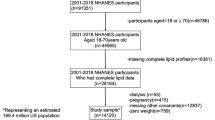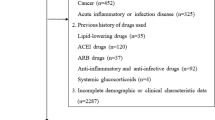Abstract
Aims
Limited data regarding the association between remnant cholesterol (RC) and chronic kidney disease (CKD), largely based on an estimated glomerular filtration rate (eGFR) of < 60 mL/min/1.73 m2 (low eGFR), have yielded inconsistent results, and no report has demonstrated the relationship of RC with CKD [defined as low eGFR and/or albuminuria (defined as urinary albumin-to-creatinine ratio (ACR) ≥ 30 mg/g)] in Chinese general middle-aged and elderly population. Hence, we aimed to investigate the association between RC and CKD in such population.
Methods
In total, 7356 Chinese participants aged ≥ 40 years were recruited from five regional communities in Luzhou city between May 2011 and December 2011. Fasting RC was calculated from the lipid profile measured by standard laboratory procedures. Multivariate logistic regression models were used to evaluate the possible association between RC and CKD.
Results
Participants in the highest quartile of RC had higher body mass index, systolic and diastolic blood pressure, total cholesterol, triglyceride, low-density lipoprotein cholesterol (LDL-C), fasting and 2-h postload blood glucose, glycated hemoglobin A1C, prevalence of prediabetes, type 2 diabetes mellitus (T2DM), hypertension, CKD, albuminuria, low eGFR, and lower high-density lipoprotein cholesterol (HDL-C) and eGFR compared with those in the lowest quartile (all P for trend < 0.01). Multivariate logistic regression analysis demonstrated that the risk of CKD gradually increased across RC quartiles (P for trend < 0.01), and participants in the highest quartile of RC were at a significantly increased risk of prevalent CKD compared to those in the lowest quartile in total subjects (odds rate: 1.344, 95% confidence intervals 1.097–1.648, P < 0.01). In subgroup analysis, significant relation between RC level and increased risk of prevalent CKD was detected in women, subjects with overweight/obesity, non-prediabetes, hypertension, normal HDL-C, appropriate and high LDL-C, and without cardiovascular disease (CVD) events after multiple adjustments.
Conclusions
Higher RC is independently associated with increased risk of prevalent CKD, and RC might serve as a new risk biomarker for CKD in a general middle-aged and elderly Chinese population, especially in women, subjects with overweight/obesity, non-prediabetes, hypertension, normal HDL-C, appropriate and high LDL-C, and without CVD events.



Similar content being viewed by others
References
Reiss AB, Voloshyna I, De Leon J, Miyawaki N, Mattana J (2015) Cholesterol metabolism in CKD. Am J Kidney Dis 66:1071–1082
Schiffrin EL, Lipman ML, Mann JF (2007) Chronic kidney disease: effects on the cardiovascular system. Circulation 116:85–97
López-Novoa JM, Martínez-Salgado C, Rodríguez-Peña AB, López-Hernández FJ (2010) Common pathophysiological mechanisms of chronic kidney disease: therapeutic perspectives. Pharmacol Ther 128:61–81
Zuo PY, Chen XL, Liu YW, Zhang R, He XX, Liu CY (2015) Non-HDL-cholesterol to HDL-cholesterol ratio as an independent risk factor for the development of chronic kidney disease. Nutr Metab Cardiovasc Dis 25:582–587
Miao L, Min Y, Qi B et al (2021) Causal effect between total cholesterol and HDL cholesterol as risk factors for chronic kidney disease: a Mendelian randomization study. BMC Nephrol 22:35
Zhang L, Yuan Z, Chen W et al (2014) Serum lipid profiles, lipid ratios and chronic kidney disease in a Chinese population. Int J Environ Res Public Health 11:7622–7635
Zhang YB, Sheng LT, Wei W et al (2020) Association of blood lipid profile with incident chronic kidney disease: a Mendelian randomization study. Atherosclerosis 300:19–25
Ye X, Kong W, Zafar MI, Chen LL (2019) Serum triglycerides as a risk factor for cardiovascular diseases in type 2 diabetes mellitus: a systematic review and meta-analysis of prospective studies. Cardiovasc Diabetol 18:48
Saeed A, Feofanova EV, Yu B et al (2018) Remnant-like particle cholesterol, low-density lipoprotein triglycerides, and incident cardiovascular disease. J Am Coll Cardiol 72:156–169
Chen J, Kuang J, Tang X et al (2020) Comparison of calculated remnant lipoprotein cholesterol levels with levels directly measured by nuclear magnetic resonance. Lipids Health Dis 19:132
Bermudez-Lopez M, Forne C, Amigo N et al (2019) An in-depth analysis shows a hidden atherogenic lipoprotein profile in non-diabetic chronic kidney disease patients. Expert Opin Ther Targets 23:619–630
Hayashi T, Hirano T, Taira T et al (2008) Remarkable increase of apolipoprotein B48 level in diabetic patients with end-stage renal disease. Atherosclerosis 197:154–158
Hirano T (1999) Lipoprotein abnormalities in diabetic nephropathy. Kidney Int 71:S22-24
Deighan CJ, Caslake MJ, McConnell M, Boulton-Jones JM, Packard CJ (2001) The atherogenic lipoprotein phenotype: small dense LDL and lipoprotein remnants in nephrotic range proteinuria. Atherosclerosis 157:211–220
Oda H, Yorioka N, Okushin S et al (1997) Remnant-like particle cholesterol may indicate atherogenic risk in patients on chronic hemodialysis. Nephron 76:7–14
Li B, Wang A, Wang Y et al (2020) A study on the correlation between remnant cholesterol and urinary albumin to creatinine ratio in Chinese community adults: a report from the REACTION study. J Diabetes 12:870–880
Groop PH, Elliott T, Ekstrand A et al (1996) Multiple lipoprotein abnormalities in type I diabetic patients with renal disease. Diabetes 45:974–979
Rahman M, Yang W, Akkina S et al (2014) Relation of serum lipids and lipoproteins with progression of CKD: the CRIC study. Clin J Am Soc Nephrol 9:1190–1198
Rysz-Gorzynska M, Gluba-Brzozka A, Banach M (2017) High-density lipoprotein and low-density lipoprotein subfractions in patients with chronic kidney disease. Curr Vasc Pharmacol 15:144–151
Levey AS, Eckardt KU, Tsukamoto Y et al (2005) Definition and classification of chronic kidney disease: a position statement from Kidney Disease: Improving Global Outcomes (KDIGO). Kidney Int 67:2089–2100
Lu J, He J, Li M et al (2019) Predictive value of fasting glucose, postload glucose, and hemoglobin A1C on risk of diabetes and complications in Chinese adults. Diabetes Care 42:1539–1548
Bi Y, Lu J, Wang W et al (2014) Cohort profile: risk evaluation of cancers in Chinese diabetic individuals: a longitudinal (REACTION) study. J Diabetes 6:147–157
Horio M, Imai E, Yasuda Y, Watanabe T, Matsuo S (2010) Modification of the CKD epidemiology collaboration (CKD-EPI) equation for Japanese: accuracy and use for population estimates. Am J Kidney Dis 56:32–38
Wang YX, Wang AP, Ye YN et al (2019) Elevated triglycerides rather than other lipid parameters are associated with increased urinary albumin to creatinine ratio in the general population of China: a report from the REACTION study. Cardiovasc Diabetol 18:57
Yano Y, Sato Y, Fujimoto S et al (2012) Association of high pulse pressure with proteinuria in subjects with diabetes, prediabetes, or normal glucose tolerance in a large Japanese general population sample. Diabetes Care 35:1310–1315
Hussein AA, Uno K, Wolski K et al (2011) Peripheral arterial disease and progression of coronary atherosclerosis. J Am Coll Cardiol 57:1220–1225
Wen J, Chen Y, Huang Y et al (2017) Association of the TG/HDL-C and Non-HDL-C/HDL-C ratios with chronic kidney disease in an adult Chinese population. Kidney Blood Press Res 42:1141–1154
Cao Y, Sun G, Liu R et al (2019) Plasma triglyceride levels and central obesity predict the development of kidney injury in Chinese community older adults. Ren Fail 41:946–953
Xu J, Chen YQ, Zhao SP, Liu L (2019) Determination of optimal cut-off points after a high-fat meal corresponding to fasting elevations of triglyceride and remnant cholesterol in Chinese subjects. Lipids Health Dis 18:206
Mancuso P, Bouchard B (2019) The impact of aging on adipose function and adipokine synthesis. Front Endocrinol 10:137
Qin S, Wang A, Gu S et al (2021) Association between obesity and urinary albumin-creatinine ratio in the middle-aged and elderly population of Southern and Northern China: a cross-sectional study. BMJ Open 11:e040214
Howard BV, Criqui MH, Curb JD et al (2014) Risk factor clustering in the insulin resistance syndrome and its relationship to cardiovascular disease in postmenopausal white, black, hispanic, and Asian/Pacific Islander women. Metabolism 52:362–371
Polkinghorne KR, Wolfe R, Jachno KM et al (2019) Prevalence of chronic kidney disease in the elderly using the ASPirin in reducing events in the elderly study cohort. Nephrology 24:1248–1256
Chang Y, Ryu S, Choi Y et al (2016) Metabolically healthy obesity and development of chronic kidney disease: a cohort study. Ann Intern Med 164:305–312
Gu S, Wang A, Ning G, Zhang L, Mu Y (2020) Insulin resistance is associated with urinary albumin-creatinine ratio in normal weight individuals with hypertension and diabetes: the REACTION study. J Diabetes 12:406–416
Moh MC, Sum CF, Tavintharan S et al (2019) Gain in adiposity over 3 years is associated with progressive renal decline in multi-ethnic South-east Asians with type 2 diabetes. J Diabetes 11:316–325
Targher G, Chonchol MB, Byrne CD (2014) CKD and nonalcoholic fatty liver disease. Am J Kidney Dis 64:638–652
Lin CY, Hsieh MC, Kor CT, Hsieh YP (2019) Association and risk factors of chronic kidney disease and incident diabetes: a nationwide population-based cohort study. Diabetologia 62:438–447
Russo GT, De Cosmo S, Viazzi F et al (2016) Plasma triglycerides and HDL-C levels predict the development of diabetic kidney disease in subjects with type 2 diabetes: the AMD annals initiative. Diabetes Care 39:2278–2287
Zeng RX, Li S, Zhang MZ et al (2017) Remnant cholesterol predicts periprocedural myocardial injury following percutaneous coronary intervention in poorly-controlled type 2 diabetes. J Cardiol 70:113–120
Varbo A, Benn M, Tybjærg-Hansen A, Jørgensen AB, Frikke-Schmidt R, Nordestgaard BG (2013) Remnant cholesterol as a causal risk factor for ischemic heart disease. J Am Coll Cardiol 61:427–436
Varbo A, Freiberg JJ, Nordestgaard BG (2015) Extreme nonfasting remnant cholesterol vs extreme LDL cholesterol as contributors to cardiovascular disease and all-cause mortality in 90000 individuals from the general population. Clin Chem 61:533–543
Nordestgaard BG, Benn M, Schnohr P, Tybjaerg-Hansen A (2007) Nonfasting triglycerides and risk of myocardial infarction, ischemic heart disease, and death in men and women. JAMA 298:299–308
Xu Y, Li M, Qin G et al (2021) Cardiovascular risk based on ASCVD and KDIGO categories in Chinese adults: a nationwide, population-based, prospective cohort study. J Am Soc Nephrol 32:927–937
Acknowledgements
The authors would like to thank all the colleagues in clinical laboratory center and endocrine laboratory, and all the nurses in our department for their hard work and valuable assistance with this study. This study was supported by the grants from the National Key New Drug Creation and Manufacturing Program of Ministry of Science and Technology (2012ZX09303006-001).
Author information
Authors and Affiliations
Corresponding author
Ethics declarations
Conflict of interest
The authors have no potential conflict of interest directly relevant to the contents of this article.
Ethical approval
The present study was approved by the Research Ethics Committees of the Rui-Jin Hospital affiliated to the Jiao-Tong University School of Medicine and also by the Affiliated Hospital of Southwest Medical University.
Human or animal rights
The study protocol conformed to the ethical guidelines of the 1975 Declaration of Helsinki.
Informed consent
Informed consent was obtained from all patients included in the study.
Additional information
Publisher's Note
Springer Nature remains neutral with regard to jurisdictional claims in published maps and institutional affiliations.
This article belongs to the topical collection Diabetic Nephropathy, managed by Giuseppe Pugliese.
Supplementary Information
Below is the link to the electronic supplementary material.
Rights and permissions
About this article
Cite this article
Yan, P., Xu, Y., Miao, Y. et al. Association of remnant cholesterol with chronic kidney disease in middle-aged and elderly Chinese: a population-based study. Acta Diabetol 58, 1615–1625 (2021). https://doi.org/10.1007/s00592-021-01765-z
Received:
Accepted:
Published:
Issue Date:
DOI: https://doi.org/10.1007/s00592-021-01765-z




